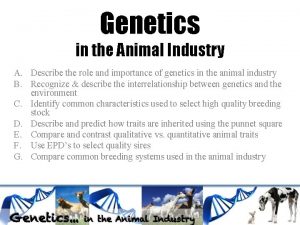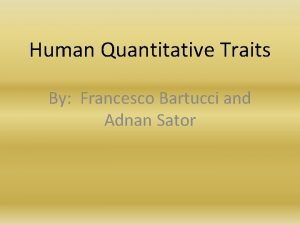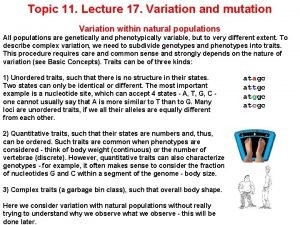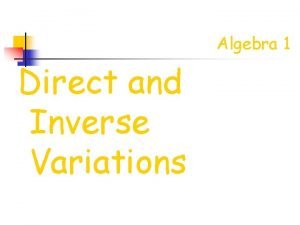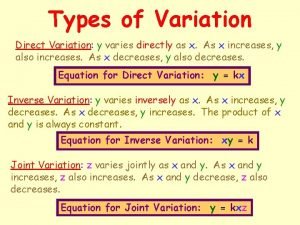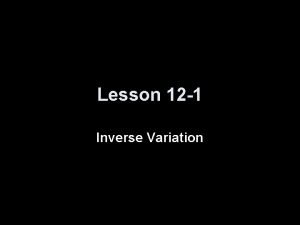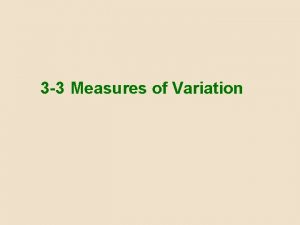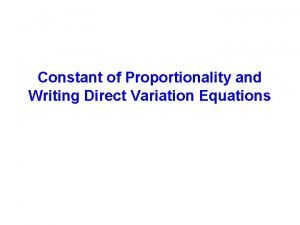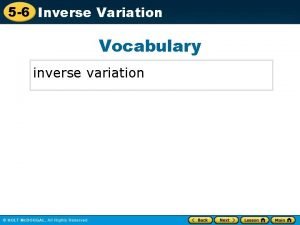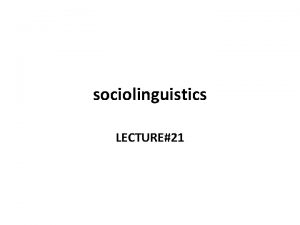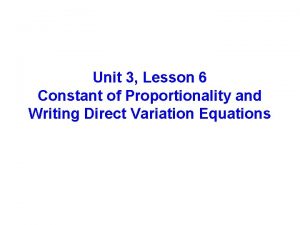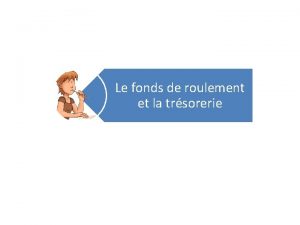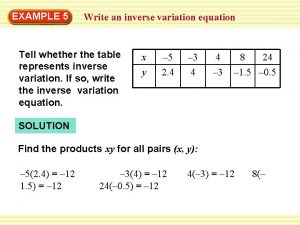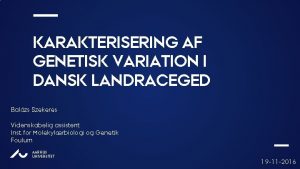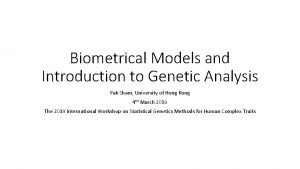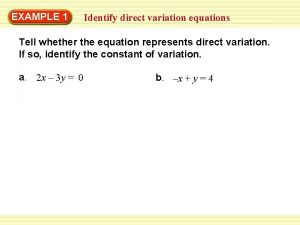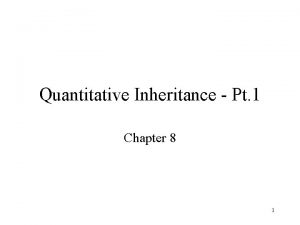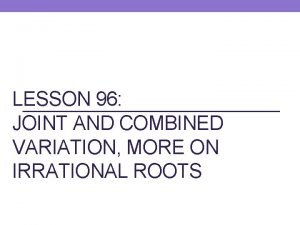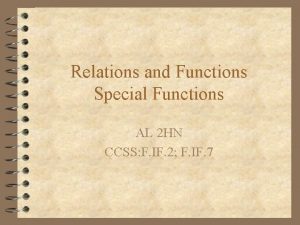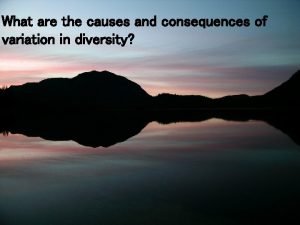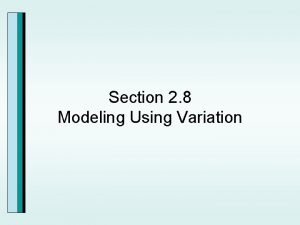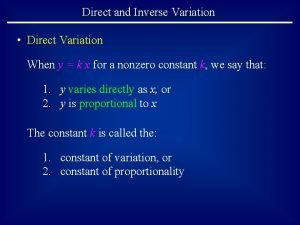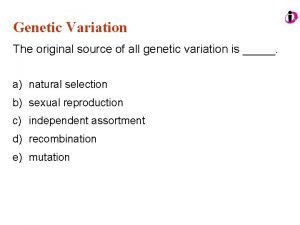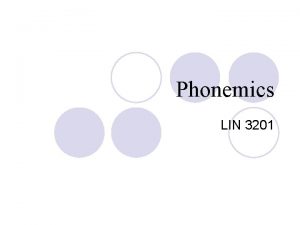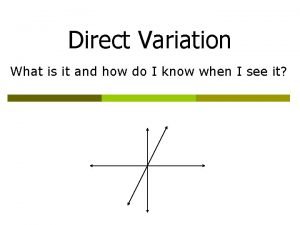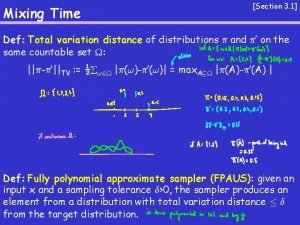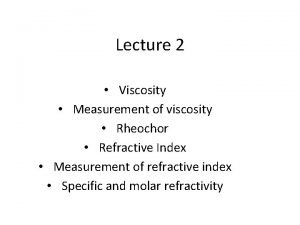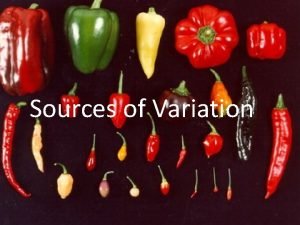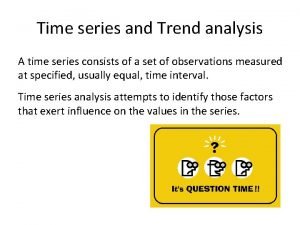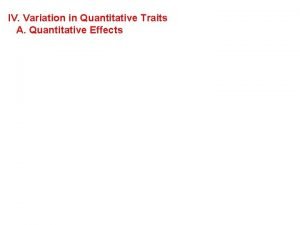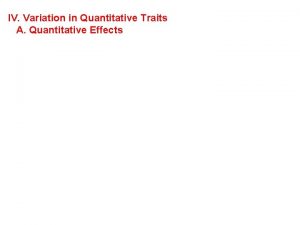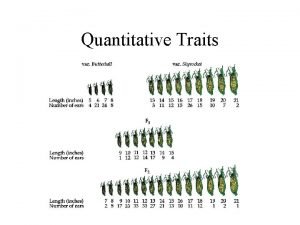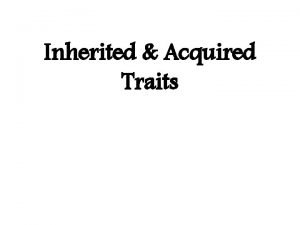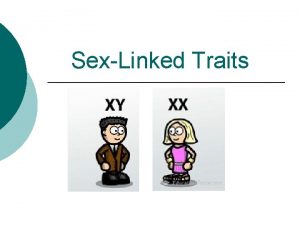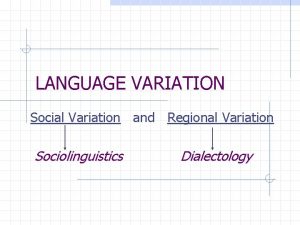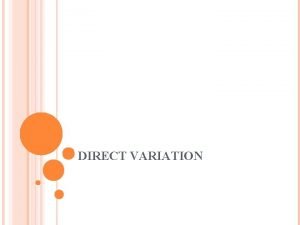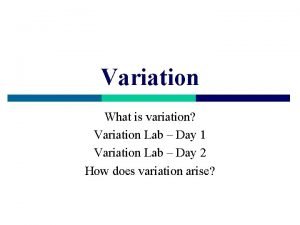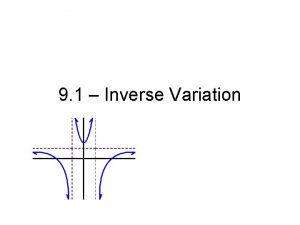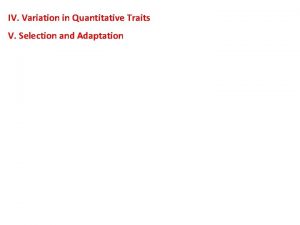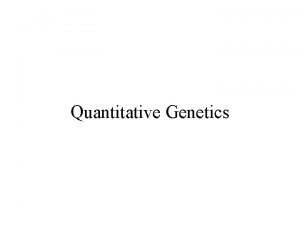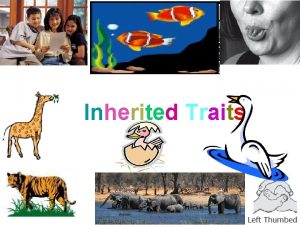IV Variation in Quantitative Traits A Quantitative Effects
































































- Slides: 64

IV. Variation in Quantitative Traits A. Quantitative Effects

IV. Variation in Quantitative Traits A. Quantitative Effects - the more factors that influence a trait (genetic and environmental) , the more 'continuously variable' the variation in that trait will be.

IV. Variation in Quantitative Traits A. Quantitative Effects - For instance, a single gene trait, with two alleles and incomplete dominance, can only have three phenotypes (variants). A two gene trait with additive effects (height ‘dose’) can make 5 phenotypes (‘dose’ = 0, 1, 2, 3, 4), and so forth.

IV. Variation in Quantitative Traits A. Quantitative Effects - the more genes that influence a trait, the more 'continuously variable' the variation in that trait will be. - For instance, a single gene trait, with two alleles and incomplete dominance, can only have three phenotypes (variants). AA, Aa, aa (Tall, medium, short) However, a two-gene trait with incomplete dominance at both loci can have nine variants: AA, Aa, aa X BB, Bb, bb - So, as the number of genes affecting a trait increase, the variation possible can increase multiplicatively.

IV. Variation in Quantitative Traits A. Quantitative Effects - the more genes that influence a trait, the more 'continuously variable' the variation in that trait will be. - For instance, a single gene trait, with two alleles and incomplete dominance, can only have three phenotypes (variants). AA, Aa, aa (Tall, medium, short) However, a two-gene trait with incomplete dominance at both loci can have nine variants: AA, Aa, aa X BB, Bb, bb -So, as the number of genes affecting a trait increase, the variation possible can increase multiplicatively. -If there are environmental effects, then the distribution of phenotypes can be continuous.

IV. Variation in Quantitative Traits A. Quantitative Effects B. Partitioning Variance 1. Partitioning Phenotypic Variance

IV. Variation in Quantitative Traits A. Quantitative Effects B. Partitioning Variance 1. Partitioning Phenotypic Variance - The phenotypic variation that we see in continuous traits is due to a number of factors that can be "lumped" as environmental or genetic. V(phen) = V(env) + V(gen)

IV. Variation in Quantitative Traits A. Quantitative Effects B. Partitioning Variance 1. Partitioning Phenotypic Variance - The phenotypic variation that we see in continuous traits is due to a number of factors that can be "lumped" as environmental or genetic. V(phen) = V(env) + V(gen) - Actually, even this is a gross simplification, because it does not recognize the contribution that Genotype-by-Environment interactions can have. V(phen) = V(e) + V(g) + V(e*g)

- Actually, even this is a gross simplification, because it does not recognize the contribution that Genotype-by-Environment interactions can have. V(phen) = V(e) + V(g) + V(e*g) GENOTYPE 1 AND THESE CAN BE VERY IMPORTANT: PHENOTYPE GENOTYPE 2 ENV 1 ENV 2

The "direct effect" of environment would compare mean phenotype of organisms in Env 1 vs. mean phenotype in Env 2. There is no difference. GENOTYPE 1 PHENOTYPE GENOTYPE 2 ENV 1 ENV 2

The "direct effect" of 'genotype' would compare mean phenotype of Genotype 1 vs. mean phenotype of Genotype 2. There is no difference. GENOTYPE 1 PHENOTYPE GENOTYPE 2 ENV 1 ENV 2

But there is a SIGNIFICANT "genotype x environment" interaction. The effect of environment on the phenotype depends on the genotype. This important component of variation is often obscured in simplistic direct models. GENOTYPE 1 PHENOTYPE GENOTYPE 2 ENV 1 ENV 2

For example: =E Height =B Mather Stanford

IV. Variation in Quantitative Traits A. Quantitative Effects B. Partitioning Variance 1. Partitioning Phenotypic Variance - The phenotypic variation that we see in continuous traits is due to a number of factors that can be "lumped" as environmental or genetic. V(phen) = V(env) + V(gen) - Actually, even this is a gross simplification, because it does not recognize the contribution that Genotype-by-Environment interactions can have. V(phen) = V(e) + V(g) + V(e*g) - Ultimately, the goal of evolutionary studies is to determine the contribution of genetic variation, because this is the only variation that is heritable and can evolve. “Broad-sense” heritability = H 2 = Vg/Vp Heritable variation: the genetic variation that makes offspring look like a parent.

IV. Variation in Quantitative Traits A. Quantitative Effects B. Partitioning Variance 1. Partitioning Phenotypic Variance - The phenotypic variation that we see in continuous traits is due to a number of factors that can be "lumped" as environmental or genetic. V(phen) = V(env) + V(gen) - Actually, even this is a gross simplification, because it does not recognize the contribution that Genotype-by-Environment interactions can have. V(phen) = V(e) + V(g) + V(e*g) - Ultimately, the goal of evolutionary studies is to determine the contribution of genetic variation, because this is the only variation that is heritable and can evolve. “Broad-sense” heritability = H 2 = Vg/Vp PROBLEMS: 1 – not all ‘genetic variation’ is heritable

IV. Variation in Quantitative Traits A. Quantitative Effects B. Partitioning Variance 1. Partitioning Phenotypic Variance 2. Partitioning Genetic Variation

IV. Variation in Quantitative Traits A. Quantitative Effects B. Partitioning Variance 1. Partitioning Phenotypic Variance 2. Partitioning Genetic Variation In sexually reproducing species, parents do not pass ALL their genes to each offspring. Therefore, similarity of phenotype in a common environment CAN’T be due to the PARENT’S genotype, alone. Suppose a parent contributes an ‘a’ allele to an offspring. What could make it’s phenotypic effect DIFFERENT in the offspring from effect in parent?

IV. Variation in Quantitative Traits A. Quantitative Effects B. Partitioning Variance 1. Partitioning Phenotypic Variance 2. Partitioning Genetic Variation In sexually reproducing species, parents do not pass ALL their genes to each offspring. Therefore, similarity of phenotype in a common environment CAN’T be due to the PARENT’S genotype, alone. Suppose a parent contributes an ‘a’ allele to an offspring. What could make it’s phenotypic effect DIFFERENT in the offspring from effect in parent? - other alleles at that locus that dominate it. (‘dominance’ effects) - other genes at different loci that affect it epistatically. (‘epistatic effects) There is variation due to 'additive' genetic variance, 'dominance' genetic variance, 'epistasis', and a variety of other contributors (sex linkage) that can be modeled. V(g) = V(a) + V(d) + V(ep)

IV. Variation in Quantitative Traits A. Quantitative Effects B. Partitioning Variance 1. Partitioning Phenotypic Variance 2. Partitioning Genetic Variation - Even the genetic variation is more complex than one might think. There is variation due to 'additive' genetic variance, 'dominance' genetic variance, 'epistasis', and a variety of other contributors that can be modeled. - We will concern ourselves with 'additive variation' Consider the “a” locus. If the 'A' allele is adaptive, then AA individuals will have higher fitness than the mean fitness of the population. Their offspring, as a consequence of inheriting this adaptive gene, will also have a higher fitness than the population, as a whole. This allele 'adds' fitness. 2 A’s (AA) adds more if the gene exhibits incomplete dominance.

IV. Variation in Quantitative Traits A. Quantitative Effects B. Partitioning Variance 1. Partitioning Phenotypic Variance 2. Partitioning Genetic Variation 3. Heritability - Broad-sense (H 2) = V(g)/V(p) PROBLEMS: 1 – not all ‘genetic variation’ is heritable 2. – usually measured by: - A ‘common garden’ experiment: - Assume V(e) = 0 - attribute all differences to genetics (combines additive, dominance, and env).

IV. Variation in Quantitative Traits A. Quantitative Effects B. Partitioning Variance 1. Partitioning Phenotypic Variance 2. Partitioning Genetic Variation 3. Heritability - Broad-sense (H 2) = V(g)/V(p) PROBLEMS: 1 – not all ‘genetic variation’ is heritable 2. – usually measured by: - A ‘common garden’ experiment: - Raise ‘clones’ in different environments - Assume V(g) = 0 - attribute all differences to the environment - denies possibility fo G X E effect MORE in a BIT…

IV. Variation in Quantitative Traits A. Quantitative Effects B. Partitioning Variance 1. Partitioning Phenotypic Variance 2. Partitioning Genetic Variation 3. Heritability - Broad-sense (H 2) = V(g)/V(p) - Narrow-sense (h 2) = V(a)/V(p) An easier way to correctly measure the genetic contribution to similarities between offspring and parents.

Calculate the average phenotype of two parents, and calculate the average phenotype of their offspring. Graph these points across sets of parents and their offspring. The slope of the best-fit line (least-squares linear regression) describes the strength of the “heritability” of the trait.

IV. Variation in Quantitative Traits A. Quantitative Effects B. Partitioning Variance 1. Partitioning Phenotypic Variance 2. Partitioning Genetic Variation 3. Calculating Heritability from Selection Experiments - Consider a variable population, with mean phenotype = x. x

IV. Variation in Quantitative Traits A. Quantitative Effects B. Partitioning Variance 1. Partitioning Phenotypic Variance 2. Partitioning Genetic Variation 3. Calculating Heritability from Selection Experiments - Consider a variable population, with mean phenotype = x. - Select organisms with a more extreme phenotype (x + 5) to breed. x Breeders, mean= x+5

IV. Variation in Quantitative Traits A. Quantitative Effects B. Partitioning Variance 1. Partitioning Phenotypic Variance 2. Partitioning Genetic Variation 3. Calculating Heritability from Selection Experiments - Consider a variable population, with mean phenotype = x. - Select organisms with a more extreme phenotype (x + 5) to breed. x Breeders, mean= x+5 - - The selection differential, S = (mean of breeders) - (mean of pop) S = (x + 5) - (x) = 5

IV. Variation in Quantitative Traits A. Quantitative Effects B. Partitioning Variance 1. Partitioning Phenotypic Variance 2. Partitioning Genetic Variation 3. Calculating Heritability from Selection Experiments - Consider a variable population, with mean phenotype = x. - Select organisms with a more extreme phenotype (x + 5) to breed. Breeders, mean= x+5 S= 5 x Measure Offspring calculate mean = x + 4 x 1

IV. Variation in Quantitative Traits A. Quantitative Effects B. Partitioning Variance 1. Partitioning Phenotypic Variance 2. Partitioning Genetic Variation 3. Calculating Heritability from Selection Experiments - Consider a variable population, with mean phenotype = x. - Select organisms with a more extreme phenotype (x + 5) to breed. x Breeders, mean= x+5 S= 5 Measure Offspring calculate mean = x + 4 x 1 R = ‘response to selection = (mean of offspring) – (mean of original population) = (x + 4) – x = 4.

IV. Variation in Quantitative Traits A. Quantitative Effects B. Partitioning Variance 1. Partitioning Phenotypic Variance 2. Partitioning Genetic Variation 3. Calculating Heritability from Selection Experiments - Consider a variable population, with mean phenotype = x. - Select organisms with a more extreme phenotype (x + 5) to breed. Breeders, mean= x+5 S= 5 x - Selection Diff. = 5 - Response = 4 Narrow-sense heritability = h 2 = R/S = 0. 8 x 1

IV. Variation in Quantitative Traits A. Quantitative Effects B. Partitioning Variance 1. Partitioning Phenotypic Variance 2. Partitioning Genetic Variation 3. Calculating Heritability from Selection Experiments - Consider a variable population, with mean phenotype = x. - Select organisms with a more extreme phenotype (x + 5) to breed. Breeders, mean= x+5 S= 5 x - Selection Diff. = 5 - Response = 4 x 1 Narrow-sense heritability = h 2 = R/S = 0. 8 The more the offspring ‘look-like” their parents, the greater the h 2

IV. Variation in Quantitative Traits A. Quantitative Effects B. Partitioning Variance 1. Partitioning Phenotypic Variance 2. Partitioning Genetic Variation 3. Calculating Heritability from Selection Experiments As selection proceeds, most variation is environmental or dominance and response to selection slows. 1. 0 x F(Additive genes) xt

- So, counterintuitively, adaptive traits may show low heritability. . . they have already been selected for, and most of the phenotypic variation NOW is probably environmental. EXAMPLE: Polar bears all have genetically determined white fur - it has been adaptive and has become fixed in their population. But they still vary in coat color (phenotype) as a result of dirt, etc. But the offspring of dirty bears will be just as white as the offspring of clean bears. . . no response to selection for 'dirty bears' because all the variation is environmental at this point.

IV. Variation in Quantitative Traits A. Quantitative Effects B. Partitioning Variance 1. Partitioning Phenotypic Variance 2. Partitioning Genetic Variation 3. Calculating Heritability from Selection Experiments 4. Misuses of Heritability: Heritability is a property of a trait, in a given population, in a given environment. It provides no insight for comparisons across populations in different environments…. Why?

IV. Variation in Quantitative Traits A. Quantitative Effects B. Partitioning Variance 1. Partitioning Phenotypic Variance 2. Partitioning Genetic Variation 3. Calculating Heritability from Selection Experiments 4. Misuses of Heritability: Heritability is a property of a trait, in a given population, in a given environment. It provides no insight for comparisons across populations in different environments…. Why? GENOTYPE X ENVIRONMENT INTERACTIONS

Consider the growth of these individual (and genetically different) plants in a common garden in Stanford, CA. These differences are GENOTYPIC DIFFERENCES, because the environmental variation is “ 0” (same environment).

Can we use these data to predict how these genotypes would grow, relative to one another, in another environment? Consider the growth of these individual (and genetically different) plants in a common garden in Stanford, CA. These differences are GENOTYPIC DIFFERENCES, because the environmental variation is “ 0” (same environment).

No. Although there is high heritability in BOTH populations for plant height. Can we use these data to predict how these genotypes would grow, relative to one another, in another environment? Consider the growth of these individual (and genetically different) plants in a common garden in Stanford, CA. These differences are GENOTYPIC DIFFERENCES, because the environmental variation is “ 0” (same environment).

IV. Variation in Quantitative Traits A. Quantitative Effects B. Partitioning Variance 1. Partitioning Phenotypic Variance 2. Partitioning Genetic Variation 3. Heritability 4. Misuses of Heritability: Heritability DOES NOT equal “genetically based” Many traits that are determined genetically are fixed, with no genetic variation, and so have very low heritability.

IV. Variation in Quantitative Traits A. Quantitative Effects B. Partitioning Variance 1. Partitioning Phenotypic Variance 2. Partitioning Genetic Variation 3. Heritability 4. Misuses of Heritability: Heritability DOES NOT equal “genetically based” 1) Many traits that are determined genetically are fixed, with no genetic variation, and so have very low heritability. 2) IF heritability is measured on one population in one environment, you cannot ascribe phenotypic variation BETWEEN groups – especially if they are in different environments, to ‘heritability’ and genetic factors. Ethnic groups differ in mean I. Q. And when measured in one population, I. Q. is heritable. But that doesn’t mean that “genetic differences” explain the difference between ethic groups in this trait…. Especially because environments vary.

MZ-DZ twin studies: Vp = Vg + Ve - MZ twins: Vg = 0, so Vp for a trait = only Ve. twin studies: Some social psychologists believe that we can determine “heritability” or “genetic contribution” (!) to a trait by examining the degree of similarity between ‘monozygotic’ (identical) and ‘dizygotic’ (fraternal) twins.

MZ-DZ twin studies: Vp = Vg + Ve - MZ twins: Vg = 0, so Vp for a trait = only Ve. - DZ twins: Us DZ twins to measure Vg = Vp – Ve (mz) - problem: MZ twins are often treated more alike than DZ twins. So, many of their similarities may be environmental, too. Thus, Ve is underestimated. - when this artificially LOW Ve is subtracted from Vp for DZ twins, it OVERESTIMATES the genetic contribution to that trait. For MZ twins, clothes choice shows very little variation. (Ve = 0. 1).

MZ-DZ twin studies: Vp = Vg + Ve - MZ twins: Vg = 0, so Vp for a trait = only Ve. - DZ twins: Us DZ twins to measure Vg = Vp – Ve (mz) - problem: MZ twins are often treated more alike than DZ twins. So, many of their similarities may be environmental, too. Thus, Ve is underestimated. - when this artificially LOW Ve is subtracted from Vp for DZ twins, it OVERESTIMATES the genetic contribution to that trait. For MZ twins, clothes choice shows very little variation. (Ve = 0. 1). DZ twins dress different (Vp = 10. 0). Vg = Vp – Ve = 10. 0 – 0. 1 = 9. 9 H 2 for ‘clothes wearing’ = Vg/Vp = 9. 9/10. 0 = 0. 99. WOW! WHAT A HUGE GENETIC CONTRIBUTION!!!

MZ-DZ twin studies: Vp = Vg + Ve Hmmmm… MZ twins are treated more similarly than DZ twins in their homes, so Ve differs between the groups. Hmmmm…. Suppose we compare MZ and DZ twins reared apart, through adoption? Then Ve will be the same across groups, and greater similarity among MZ twins must be a function of greater genetic similarity. MZ DZ “The Jim Twins” Ve is the same for both groups

• As youngsters, each Jim had a dog named "Toy. " • Each Jim had been married two times -- the first wives were both called "Linda" and the second wives were both called "Betty. " • One Jim had named his son "James Allan" and the other Jim had named his son "James Alan. " • Each twin had driven his light-blue Chevrolet to Pas Grille beach in Florida for family vacations. • Both Jims smoked Salem cigarettes and drank Miller Lite beer. • Both Jims had at one time held part-time posts as sheriffs. • Both were fingernail biters and suffered from migraine headaches. • Each Jim enjoyed leaving love notes to his wife throughout the house.

I. Q. : Statistically significant differences in mean performances of ethnic groups in U. S. Also, I. Q. (as measured in single populations) is heritable. “Most scholars accept that I. Q. in the human species as a whole is substantially heritable, somewhere between 40 percent and 80 percent, meaning that much of the observed variation in I. Q. is genetic. ” – Murray and Herrnstein (1994). No. And even if so, so what? Much of the variation is environmental.

IV. Variation in Quantitative Traits C. Identifying Loci Contributing to Quantitative Traits 1. Quantitative Trait Loci (QTL) mapping Monkeyflowers – genus Mimulus (Bradshaw et al. 1998)

Occur in the Sierras, with overlapping elevational distributions. They readily hybridize, but no hybrids are found in nature – possibly because they attract different pollinators. The species vary in flower shape and structure. Since they each “breed true” for their particular phenotypes, we assume they are homozygous at loci influencing these traits. Since they hybridize, we can form heterozygous F 1’s (b). Mating F 1’s creates F 2’s, which show quantitative variation in color, shape, and nectar volume (12 measured traits, like corolla width, stamen length, anthocyanins in petal, etc. ) M. Lewisii F 1 M. cardinalis

M. lewisii M. cardinalis AABBCCDD aabbccdd F 1 Aa. Bb. Cc. Dd X Aa. Bb. Cc. Dd Number of genotypes possible in F 2?

M. lewisii M. cardinalis AABBCCDD aabbccdd F 1 Aa. Bb. Cc. Dd X Aa. Bb. Cc. Dd Number of genotypes possible in F 2? A B C D AA Aa Aa BB Bb bb CC Cc cc DD Dd dd 3 x 3 x 3 = 81 genotypic combinations

Identify ‘marker’ loci across the genome – loci that are: 1 - unique in the genome 2 – homozygous in each species 3 – distributed over all chromosomes These are often “single nucleotide polymorphisms” (SNP’s), repeats, transposons, restrictions sites SNP: Single bases that differ between the species at a given point in the genome. M. lewisii: CCCTTGCA All homozygous for C in this position M. cardinalis: C C A T T G C A All homozygous for A in this position M. Lewisii F 1 M. cardinalis

Identify ‘marker’ loci across the genome – loci that are: 1 - unique in the genome 2 – homozygous in each species 3 – distributed over all chromosomes The Goal: Find associations between F 2 ‘marker’ genotypes and either color or shape. Many genes with small effects or a few genes with large effects? So, maybe (j) and (g) are homozygous with the M. lewisii allele at markers 1 and 5, while (l) is homozygous for the M. cardinalis marker allele at markers 1 and 5. This association between marker genotype and parental phenotype suggests that there are QTL’s for color and/or shape near markers 1 and 5. M. Lewisii F 1 M. cardinalis

Identify ‘marker’ loci across the genome – loci that are: 1 - unique in the genome 2 – homozygous in each species 3 – distributed over all chromosomes The Goal: Find associations between F 2 ‘marker’ genotypes and either color or shape. Many genes with small effects or a few genes with large effects? WHY would the association occur? WHY might the “C” SNP from M. lewisii show up at a higher frequency than expected with the PINK color of F 2 individuals, while the “A” SNP from M. cardinalis shows up in greater frequency of F 2 with red flowers? M. Lewisii F 1 M. cardinalis

Identify ‘marker’ loci across the genome – loci that are: 1 - unique in the genome 2 – homozygous in each species 3 – distributed over all chromosomes The Goal: Find associations between F 2 ‘marker’ genotypes and either color or shape. Many genes with small effects or a few genes with large effects? WHY would the association occur? WHY might the “C” SNP from M. lewisii show up at a higher frequency than expected with the PINK color of F 2 individuals, while the “A” SNP from M. cardinalis shows up in greater frequency of F 2 with red flowers? LINKAGE M. Lewisii F 1 M. cardinalis

Identify ‘marker’ loci across the genome – loci that are: 1 - unique in the genome 2 – homozygous in each species 3 – distributed over all chromosomes The Goal: So, we have used the concept of linkage (and “linkage disequilibrium”, really) between a marker locus and phenotypic trait to isolate a region that influences the trait. Markers that are associated with a phenotypic trait are: Quantitative Trait Loci (QTL’s) M. Lewisii F 1 M. cardinalis

Most relationships between markers and phenotypic traits were weak (explaining < 20% of the phenotypic variance). But a few, 9 of 12 floral traits, %’s were much higher.

One marker explained over 80% of the variation in color. Genotypes varying ONLY at this locus and are visited by bees and hummingbirds, respectively. Single genes can exert strong effects that can be driven quickly to fixation by selection. Determining the actual gene in the region, and the protein and action of the protein influencing the trait, requires additional “genetic dissection” of ‘Candidate Loci’ in the region. We only know that genetic variation in this region near the maker is associated with phenotypic variation in the trait. We don’t know the number, specific location, or gene action that creates the phenotype.


Coat color in Peromyscus polionotus

Lighter color due to mutation in Agouti locus, which interferes with the receptor (and decreases the deposition of melanin). Lighter color due to a mutation in melanocortin-1 receptor, which decreased the activity of the receptor.


GWA – Genome-wide association mapping Do not do a pedigree analysis; screen a large population (1000’s of individuals). Divide population by a phenotype: presence or absence of a disease. Do a complete analyses of their genotypes at 1000’s of markers (SNP’s). Look for non-random associations (linkage) between particular makers and a disease.

But there is a SIGNIFICANT "genotype x environment" interaction. The effect of environment on the phenotype depends on the genotype. This important component of variation is often obscured in simplistic direct models. GENOTYPE 1 PHENOTYPE GENOTYPE 2 ENV 1 ENV 2

For example: =E Height =B Mather Stanford

 Qualitative traits vs quantitative traits
Qualitative traits vs quantitative traits Qualitative traits vs quantitative traits
Qualitative traits vs quantitative traits Qualitative traits vs quantitative traits
Qualitative traits vs quantitative traits What does a direct variation graph look like
What does a direct variation graph look like Inverse eq
Inverse eq Correlation and regression
Correlation and regression Inheritance of quantitative traits
Inheritance of quantitative traits Dominant genetic variance
Dominant genetic variance Genetic variation
Genetic variation What is the difference between direct and inverse variation
What is the difference between direct and inverse variation Variation of milgram's study
Variation of milgram's study Skill of stimulus variation
Skill of stimulus variation Types of variations
Types of variations Variety dimension operations management
Variety dimension operations management Graph inverse variation
Graph inverse variation Measures of variation definition
Measures of variation definition Constant of proportionality
Constant of proportionality Which graph represents an inverse variation?
Which graph represents an inverse variation? Price variation formula
Price variation formula Direct variation slope
Direct variation slope Variation and classification
Variation and classification Dialectal variation
Dialectal variation Graphing inverse variation
Graphing inverse variation Sociolinguistics
Sociolinguistics Constant of proportionality
Constant of proportionality Definition of constant of variation
Definition of constant of variation Besoin en fond de roulement
Besoin en fond de roulement Types of language variation
Types of language variation Direct variation examples with solution
Direct variation examples with solution Genetisk variation
Genetisk variation Continuous variation
Continuous variation Direct variation equation
Direct variation equation Dominant genetic variance
Dominant genetic variance Application of somatic hybridization
Application of somatic hybridization Disintegrant excipient pricelist
Disintegrant excipient pricelist Joint and combined variation
Joint and combined variation Mathsbot starter
Mathsbot starter Example of direct variation
Example of direct variation Which graph represents a direct variation?
Which graph represents a direct variation? Special functions algebra 2
Special functions algebra 2 Consequences of variation
Consequences of variation Evolution of populations section 16-1 genes and variation
Evolution of populations section 16-1 genes and variation Inverse variation definition
Inverse variation definition Inverse variation proportion
Inverse variation proportion Modeling using variation calculator
Modeling using variation calculator Difference between continuous and discontinuous variation
Difference between continuous and discontinuous variation 미니탭 gage r&r 해석
미니탭 gage r&r 해석 Direct variation foldable
Direct variation foldable Concomitant variation
Concomitant variation What is the excluded value for this function?
What is the excluded value for this function? Direct variation
Direct variation Clinical variation reduction
Clinical variation reduction Transitory defect marks
Transitory defect marks Founder effect genetic drift
Founder effect genetic drift Red short horned cattle are homozygous for the red allele
Red short horned cattle are homozygous for the red allele Lesson 3-4 direct variation answers
Lesson 3-4 direct variation answers Difference between micro and macro teaching
Difference between micro and macro teaching Free variation and complementary distribution
Free variation and complementary distribution What is this
What is this Direct variation def
Direct variation def Unit of rheochor
Unit of rheochor Stroke volume calculation
Stroke volume calculation What are variations
What are variations Secular trend in time series
Secular trend in time series Grasshoppers in madagascar show variation
Grasshoppers in madagascar show variation


